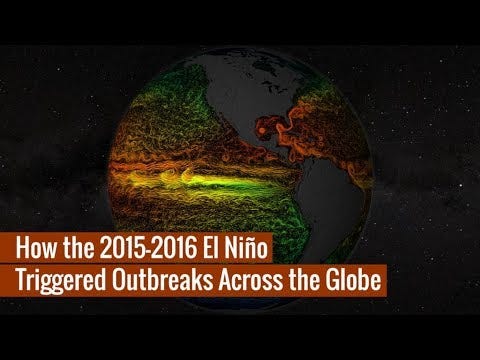A New El Nino in 2023 will be Worse for Climate than Anything in last few years
Reports say a new El Nino takes place in 2023, but this could worsen the climate situation, based on the repercussions of past El Ninos.
Credit, NASA
A new study from the United Kingdom Met Office suggests that the world could breach the 1.5 degrees Celsius threshold of warming for the first time in one of the next five years, with the probability of having such a possibility narrowing to 50:50, especially with the occurrence of an El Nino year.
A 50:50 chance exists of the annual average weather global temperature temporarily reaching 1.5 degrees Celsius above the pre-industrial level for the next five years, according to a climate update by the World Meteorological Organisation (WMO).
Temperature rose at least 1.2 Celsius above pre-industrial times this year, with temperature on land having risen above 1.5 C, Europe having seen 2C of warming and the Arctic 3C, although the warming hasn’t evenly around the globe, scientists at Intergovernmental Panel on Climate Change (IPCC) said late last year.
When the warming spreads evenly around the globe, the 50:50 chance of annual average global weather reaching 1.5 degrees Celsius becomes possible, meaning the world could breach the dreaded temperature threshold, especially with a global shift to an El Nino weather pattern later on in the year.
A major El Nino weather pattern at the beginning of 2016 paved the way for the hottest year in recorded history, with the average global temperature across land and the ocean getting to 0.94 degrees Celsius above the 20th century average of 13.9C, surpassing the previous record warmth of 2015 by 0.04C, much of the record warmth attributed to the situation in the global oceans, which was 0.75C higher than the 20th century average, edging out the previous record of 2015 by 0.01C.
In the 2009 El Nino year, the world achieved the second warmest year in the modern record as at then, with a total average global temperature increasing by about 0.8 C since 1884, and an average 0.56C above the 20th century average through October of that year, with the ocean temperature by October of that year becoming the sixth warmest on the records.
In the 1998 El Nino year, the world recorded the hottest temperature in the 20th century, as well as easily the highest temperature in the global records extending back to 1860, and the confirmed global mean temperature reached 0.56C above the recent long-term average based on the period 1961 to 1991, beating the 1997 record of 0.43C warmer than the average.
With the 1998 El Nino-fuelled temperature proving to be the hottest in the 20th century, and the 2009 year almost replicating the same status, and with the 2016 El Nino year certainly replicating the feat of the 1998 episode, it becomes plausible to believe that a record temperature fuelled by an El-Nino event could occur in the next five years, allowing the world to breach the 1.5C threshold.
From 1991 to 2017, more than 166,000 people died due to heatwaves, including more than 70,000 people who died during the 2003 heatwave in Europe, but these numbers could witness a significant increase through a 1.5C temperature in the next few years, adding significantly to the 12.5 million people exposed to heatwaves between 2000 and 2016.
A disaster related to weather, climate, or water hazard occurred everyday on average over the past 50 years, while once-in-50 years, or once-in-100 years, and once-in 300 years events now occur with frequency through the present challenge with climate change, but with temperature reaching 1.5C in 2023 or the next few years , the pace of weather-related disaster rises, a dangerous future when seen in the context of the 9.4 percent global deaths through extreme temperature recorded between 2000 and 2019.
A breaching of the 1.5C threshold could have negative effects on global crop yields, already experiencing declines, with a report suggesting that climate change could reduce global crop yield by three to 12 percent by the mid century and 11 to 25 percent by the end of the century, especially under a rigorous warming condition.
Wildlife population declined by an average 69 percent in the past 50 years, with species dying by as much as 1,000 times more frequently than before the arrival of humans 60 million years ago, but a 1.5C threshold will only worsen an already bad situation, making humanity to eventually pay a high price for the decimation of the only assemblage of life that we know of in the universe.
With a 1.5C threshold, the loss of species could become accelerated, while the reduction of global crop yield, frequency of extreme weather events, and the rising sea levels could make the extinction of humans itself on the planet to become a reality.
The solution arrives from the banning of fossil fuels. It creates a situation where the chance of at least one year between 2022-2016 temporarily exceeding 1.5 C becomes possible, increasing the state from a near zero condition in 2015. The probability of pain increases with time, and unless humanity finds a way to ditch the usage of fossil fuel, the future looks scary indeed.
What to Eat
Tanzanian cucumber salad, Credit,La Fuji Mama





The other link worth discussing is that the increased temperatures move mosquitos further into northern zones -with the diseases they carry - where they have not been able to overwinter.
That remains a public health threat as yet unregistered among most Americans.